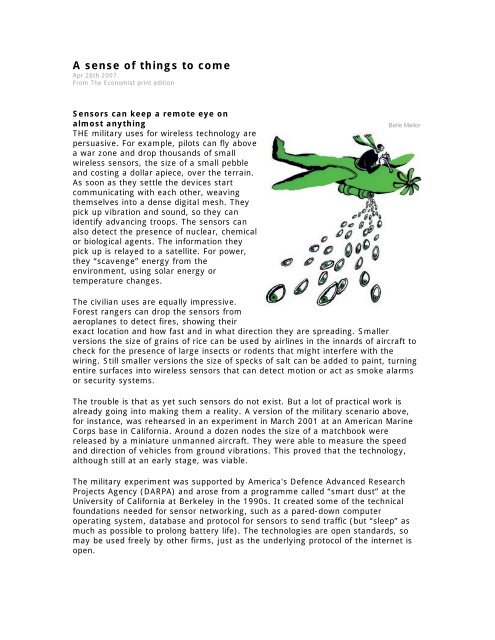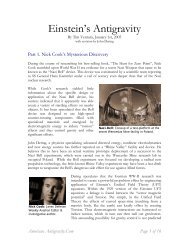A world of connections - Signal Lake Venture Fund
A world of connections - Signal Lake Venture Fund
A world of connections - Signal Lake Venture Fund
Create successful ePaper yourself
Turn your PDF publications into a flip-book with our unique Google optimized e-Paper software.
A sense <strong>of</strong> things to come<br />
Apr 26th 2007<br />
From The Economist print edition<br />
Sensors can keep a remote eye on<br />
almost anything<br />
THE military uses for wireless technology are<br />
persuasive. For example, pilots can fly above<br />
a war zone and drop thousands <strong>of</strong> small<br />
wireless sensors, the size <strong>of</strong> a small pebble<br />
and costing a dollar apiece, over the terrain.<br />
As soon as they settle the devices start<br />
communicating with each other, weaving<br />
themselves into a dense digital mesh. They<br />
pick up vibration and sound, so they can<br />
identify advancing troops. The sensors can<br />
also detect the presence <strong>of</strong> nuclear, chemical<br />
or biological agents. The information they<br />
pick up is relayed to a satellite. For power,<br />
they “scavenge” energy from the<br />
environment, using solar energy or<br />
temperature changes.<br />
Belle Mellor<br />
The civilian uses are equally impressive.<br />
Forest rangers can drop the sensors from<br />
aeroplanes to detect fires, showing their<br />
exact location and how fast and in what direction they are spreading. Smaller<br />
versions the size <strong>of</strong> grains <strong>of</strong> rice can be used by airlines in the innards <strong>of</strong> aircraft to<br />
check for the presence <strong>of</strong> large insects or rodents that might interfere with the<br />
wiring. Still smaller versions the size <strong>of</strong> specks <strong>of</strong> salt can be added to paint, turning<br />
entire surfaces into wireless sensors that can detect motion or act as smoke alarms<br />
or security systems.<br />
The trouble is that as yet such sensors do not exist. But a lot <strong>of</strong> practical work is<br />
already going into making them a reality. A version <strong>of</strong> the military scenario above,<br />
for instance, was rehearsed in an experiment in March 2001 at an American Marine<br />
Corps base in California. Around a dozen nodes the size <strong>of</strong> a matchbook were<br />
released by a miniature unmanned aircraft. They were able to measure the speed<br />
and direction <strong>of</strong> vehicles from ground vibrations. This proved that the technology,<br />
although still at an early stage, was viable.<br />
The military experiment was supported by America's Defence Advanced Research<br />
Projects Agency (DARPA) and arose from a programme called “smart dust” at the<br />
University <strong>of</strong> California at Berkeley in the 1990s. It created some <strong>of</strong> the technical<br />
foundations needed for sensor networking, such as a pared-down computer<br />
operating system, database and protocol for sensors to send traffic (but “sleep” as<br />
much as possible to prolong battery life). The technologies are open standards, so<br />
may be used freely by other firms, just as the underlying protocol <strong>of</strong> the internet is<br />
open.





